Milad Tower
Milad Tower (Persian: برج میلاد Borj e Milād), also known as the Tehran Tower (برج تهران Borj e Tehrān),[3] is a multi-purpose tower in Tehran, Iran. It is the sixth-tallest tower[4] and the 24th-tallest freestanding structure in the world.[5]
| Milad Tower | |
|---|---|
برج میلاد | |
 | |
.jpg) Milad Tower at night | |
Location within Tehran (dark blue) | |
| Alternative names | Tehran Tower |
| General information | |
| Type | Telecommunication, commercial, restaurant, observation |
| Location | Tehran, Iran |
| Coordinates | 35°44′41″N 51°22′31″E |
| Construction started | 2000 |
| Completed | 2007 |
| Opening | 7 October 2008 |
| Management | Boland Payeh Co. |
| Height | |
| Antenna spire | 435.0 m (1,427 ft) |
| Roof | 315.0 m (1,033 ft) |
| Top floor | 312.0 m (1,024 ft) |
| Technical details | |
| Floor count | 12 |
| Floor area | 154,000 m2 (1,660,000 sq ft) |
| Lifts/elevators | 6 |
| Design and construction | |
| Architect | Mohammad Reza Hafezi |
| Main contractor | Boland Payeh Co. |
| Website | |
| Official website | |
| References | |
| [1][2][3] | |
It is located between Qarb Town and the district of Gisha, standing at 435 meters from the base to the tip of the antenna.[6] The head consists of a large pod with 12 floors, the roof of which is at 315 meters.
The tower is a part of the International Trade and Convention Center of Tehran, which also includes a five-star hotel, a convention center, a world trade center and an IT park.[1][2][3]
History
Background
The Milad Tower was part of the Shahestan Pahlavi project, a vast development for a new government and commercial centre for Tehran, that was designed in the 1970s but never materialized, except for the Tower. After an international competition, the project was awarded to the Llewely Davies Company, and construction was inaugurated on August 19, 1975, with the Shah of Iran and the Mayor of Tehran Dr G.R. Nickpay burying a commemorative gold plaque .[7] There is also another background of building this tower, since the construction of the tower was started after the 1979 revolution. The new government of Iran wanted to create a new symbol for Tehran to replace the Azadi Tower that was a symbol of Pahlavi's reign.
Construction
The construction of the tower was commenced in 1997. Upon completion of its construction in the mid 2000s, the Milad Tower was considered the fourth-tallest freestanding telecommunication tower in the world.[3] While the tower opened in 2007, numerous conflicts on the history of the tower still prevail, partly because sections of the tower were open to visitors once the elevators started operating during construction and the tower was still far from finished.[1][2][3]
The design of the project was headed by Iranian architect Mohammad Reza Hafezi. The general contractor was the company of Boland Payeh, and the main client and investor was the company of Yadman Sazeh, a representative of the Municipality of Tehran.[2]
The tower was officially opened on October 7, 2008 by the 55th Mayor of Tehran, Mohammad Bagher Ghalibaf, and members of the City Council of Tehran. More than 250 local and foreign journalists were covering the event.
Structure and features

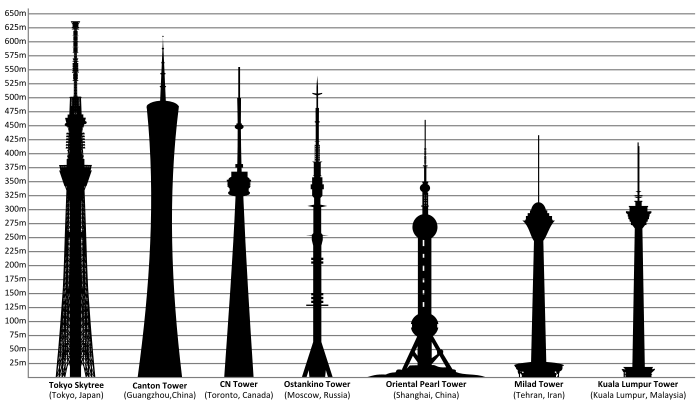
Milad Tower is 435 metres (1,427 ft) tall and is the tallest tower in Iran, and the sixth-tallest telecommunication tower in the world. It consists of five main parts, including the foundation, transition (lobby) structure, shaft, head structure and the antenna mast.
The lobby structure consists of six floors. The first three floors consist of 63 trade units, 11 food courts, a cafeteria, and a commercial products exhibition which is supposed to be about 260 square metres (2,800 sq ft).[3] The first and second underground floors consist of installing sections and a data center. The ground floor is dedicated to the entrance and the gatehouse.
The shaft is a concrete structure about 315 metres (1,033 ft) high from the ground floor. Six elevators in three different sides of the shaft are used to transfer the visitors to the head of the tower at the speed of 7 metres per second (0.0070 km/s), besides an emergency staircase at the fourth side.
The head of the tower is a steel structure weighing about 25,000 tonnes and consisting of 12 floors. The top floors of the tower include a public art gallery, a cafeteria, a revolving restaurant, a VIP restaurant, telecommunication floors, mechanical floors, fire-immune areas built as a refuge zone,[8] a closed observation deck, an open observation deck, and a sky dome.[2]
The four-stage antenna mast is about 120 metres (390 ft) high. The lower floor of the mast is for the adjustment of public users' telecommunication antennas, and the three upper floors are dedicated to the antenna of the Islamic Republic of Iran Broadcasting.[2][3]
The complex also features a parking area of about 27,000 square metres (290,000 sq ft), a large computer and telecommunications unit, a cultural and scientific unit, a commercial transaction center, a temporary showroom for exhibiting products, a specialized library, an exhibition hall, and an administrative unit.
The Milad Tower has an octagonal base, symbolizing traditional Iranian architecture.[2]
Gallery
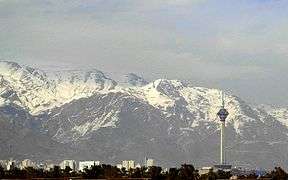 Mount Tochal and the Milad Tower seen from Chitgar Park.
Mount Tochal and the Milad Tower seen from Chitgar Park.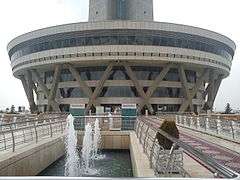 The entrance of the tower.
The entrance of the tower.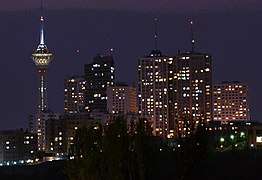 Milad Tower seen from Qarb Town.
Milad Tower seen from Qarb Town.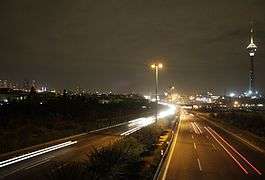 Milad Tower seen from Hemmat Expressway.
Milad Tower seen from Hemmat Expressway.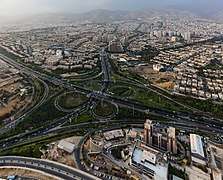 Tehran seen from the top of the Milad Tower.
Tehran seen from the top of the Milad Tower. Milad Tower's view to the city and mountains. Tower's shadow is visible.
Milad Tower's view to the city and mountains. Tower's shadow is visible.
Ranks
See also
- Fernsehturm Stuttgart – prototype (first TV tower built from concrete)
- List of revolving restaurants
- List of tallest buildings in Tehran
- International rankings of Iran
References
- "Borj-e Milad, Tehran - SkyscraperPage.com". Skyscraperpage.com. Retrieved 2012-12-29.
- Zafarani, H. "Seismic Response Analysis of Milad Tower in Tehran, Iran" (PDF). Iitk.ac.in. Retrieved 2012-12-29.
- "Milad Tower | Buildings". Emporis.com. Retrieved 2012-12-29.
- "Milad Tower, a perfect product for a perfect project". NBN (Nasl Bartar Novin). n.d. Archived from the original on November 17, 2009. Retrieved 2009-09-10.
- Andrew Burke, Mark Elliott. Iran (Lonely Planet Country Guide). p. 114. Lonely Planet Publications, 5th Edition, 2008. ISBN 978-1-74104-293-1.
- "Iran Opens World's 4th Highest Telecoms Tower". Cellular-News. 2009-09-08. Retrieved 2009-10-05.
- Shahestan Pahlavi. Book 1: The Master Plan. Llewely Davies, 1976
- "Congress Venue". IUA. 2009-03-13. Retrieved 2009-10-05.
External links


.jpg)